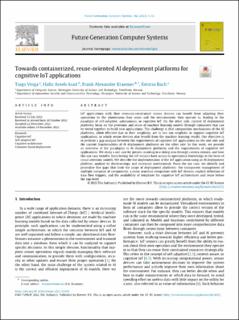| dc.contributor.author | Veiga, Tiago Santos | |
| dc.contributor.author | Asad, Hafiz Areeb | |
| dc.contributor.author | Kræmer, Frank Alexander | |
| dc.contributor.author | Bach, Kerstin | |
| dc.date.accessioned | 2023-03-14T07:22:55Z | |
| dc.date.available | 2023-03-14T07:22:55Z | |
| dc.date.created | 2022-12-31T09:38:18Z | |
| dc.date.issued | 2022 | |
| dc.identifier.citation | Future generations computer systems. 2022, 142 4-13. | en_US |
| dc.identifier.issn | 0167-739X | |
| dc.identifier.uri | https://hdl.handle.net/11250/3058034 | |
| dc.description.abstract | IoT applications with their resource-constrained sensor devices can benefit from adjusting their operations to the phenomena they sense and the environments they operate in, leading to the paradigm of self-adaptive, autonomous, or cognitive IoT. On the other side, current AI deployment platforms focus on the provision and reuse of machine learning models through containers that can be wired together to build new applications. The challenge is that composition mechanisms of the AI platforms, albeit effective due to their simplicity, are in fact too simplistic to support cognitive IoT applications, in which sensor devices also benefit from the machine learning results. Our objective is to perform a gap analysis between the requirements of cognitive IoT applications on the one side and the current functionalities of AI deployment platforms on the other side. In this work, we provide an overview of the paradigms in AI deployment platforms and the requirements of cognitive IoT applications. We study a use case for person counting in a skiing area through camera sensors, and how this use case benefits from letting the IoT sensors have access to operational knowledge in the form of visual attention models. We describe the implementation of the IoT application using an AI deployment platform, analyze its shortcomings, and necessary workarounds. From the use case, we identify and generalize five gaps that limit the usage of deployment platforms: the transparent management of multiple instances of components, a more seamless integration with IoT devices, explicit definition of data flow triggers, and the availability of templates for cognitive IoT architectures and reuse below the top-level. | en_US |
| dc.language.iso | eng | en_US |
| dc.publisher | Elsevier | en_US |
| dc.rights | Navngivelse 4.0 Internasjonal | * |
| dc.rights.uri | http://creativecommons.org/licenses/by/4.0/deed.no | * |
| dc.title | Towards containerized, reuse-oriented AI deployment platforms for cognitive IoT applications | en_US |
| dc.title.alternative | Towards containerized, reuse-oriented AI deployment platforms for cognitive IoT applications | en_US |
| dc.type | Peer reviewed | en_US |
| dc.type | Journal article | en_US |
| dc.description.version | publishedVersion | en_US |
| dc.source.pagenumber | 4-13 | en_US |
| dc.source.volume | 142 | en_US |
| dc.source.journal | Future generations computer systems | en_US |
| dc.identifier.doi | 10.1016/j.future.2022.12.029 | |
| dc.identifier.cristin | 2098340 | |
| cristin.ispublished | true | |
| cristin.fulltext | original | |
| cristin.qualitycode | 2 | |

